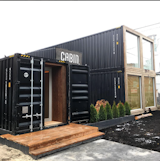While the idea of 42 stories of wooden floors stacked on top of each other may seem shaky, the SOM Timber Tower Research project showed that such a sustainable superstructure is in fact possible. The concept calls for a concrete jointed timber frame to keep the structure anchored. More research, as well as building codes changes, would need to occur before anybody breaks ground. As cities look for sustainable construction to house growing populations, architects are starting to turn to wood as a more responsible solution.
“The layout and openings allow ample flow to the exterior, and paths and decks have been developed to ‘flatten’ the sloping site enough to create generous outdoor gathering areas,” Herrin says. “These areas take into account sunlight at different times of day as well as protection from prevailing wind,” he adds. One-by-six-foot ipe planks comprise the decking, and hemlock end grain by the Oregon Lumber Company was installed indoors.
11.6k more photos



































